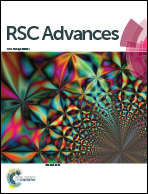Upconversion fluorescent nanoparticles based-sensor array for discrimination of the same variety red grape wines†
Abstract
In this research, a novel fluorescent sensor array based on upconversion nanomaterials (UCNPs) for the discrimination of the same variety red grape wines from different manufacturers was developed. The sensor array was composed of six elements: one positively charged UCNPs modified with guanidine groups (UCNPs@GDN), two negatively charged UCNPs modified with sulfonic acid groups (UCNPs@SO3H) and phosphonic acid groups (UCNPs@PO(OH)2), respectively, and their mixture 1 (UCNPs@GDN + UCNPs@SO3H), mixture 2 (UCNPs@GDN + UCNPs@PO(OH)2) and mixture 3 {UCNPs@GDN + UCNPs@SO3H + UCNPs@PO(OH)2}. The discrimination mechanism is mainly attributed to the emission of those upconversion fluorescent nanoparticles being quenched by organic ingredients that usually exist in red grape wines. The discrimination of red grape wines was carried out by employing UCNPs@GDN, UCNPs@SO3H and UCNPs@PO(OH)2 in pH = 7.0 HEPES buffer, the mixture 1 and mixture 2 in pH = 9.0 PBS buffer, and mixture 3 in pH = 6.0 Tris–HCl buffer. Principal component analysis (PCA) of the data obtained from our established array showed obvious distinction among the nine red grape wines from different manufacturers. The present work is expected to inspire more marvellous research in the fields of UCNPs and red grape wines identification.

- This article is part of the themed collection: Editors’ collection: Fluorescent Sensors


 Please wait while we load your content...
Please wait while we load your content...